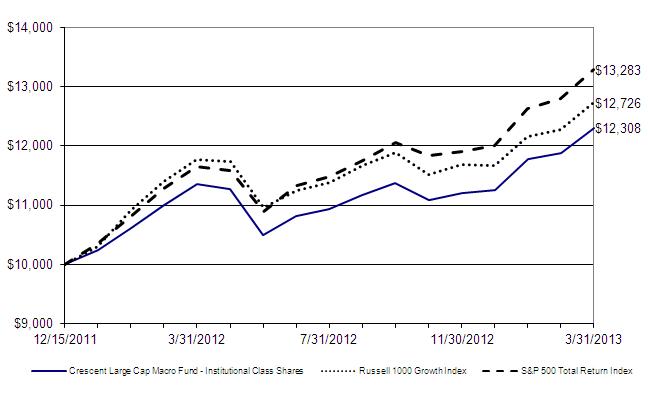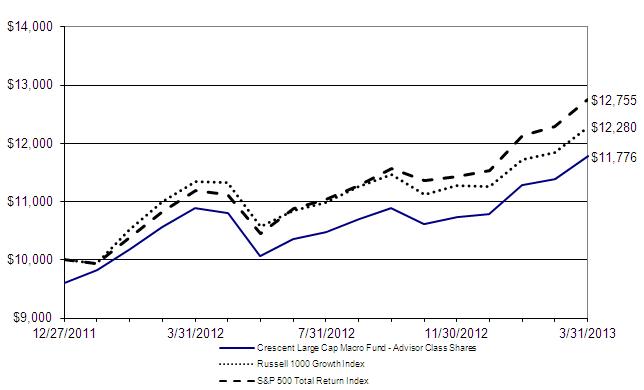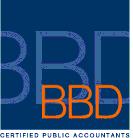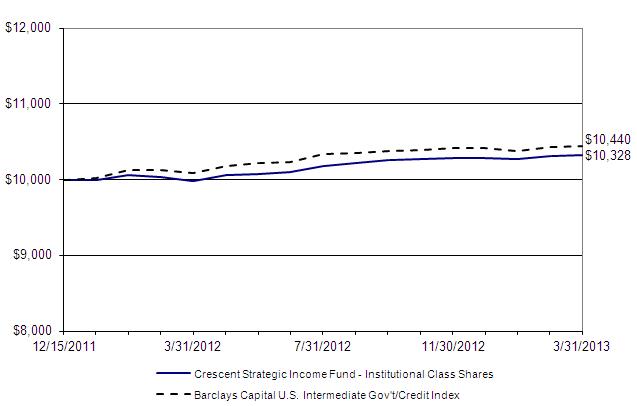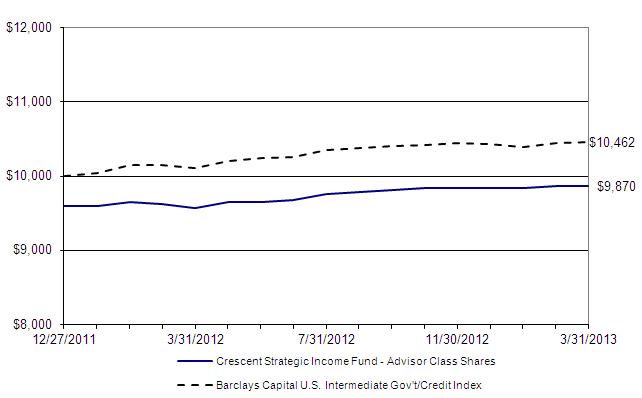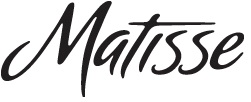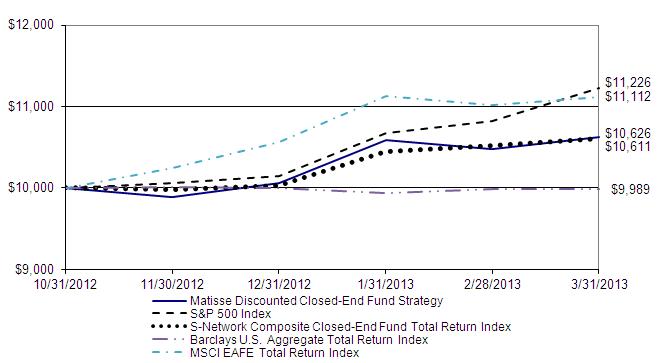Matisse Discounted Closed-End Fund Strategy
Notes to Financial Statements
| 1. | Organization and Significant Accounting Policies |
The Matisse Discounted Closed-End Fund Strategy (“Fund”) is a series of the Starboard Investment Trust (“Trust”). The Trust is organized as a Delaware statutory trust and is registered under the Investment Company Act of 1940, as amended (the “1940 Act”), as an open-end management investment company. The Fund is a separate diversified series of the Trust.
The Fund commenced operations October 31, 2012. The Fund is a “fund of funds” that seeks to achieve its investment objective of long-term capital appreciation and income principally through investments in unaffiliated closed-end funds which pay regular periodic cash distributions, the interests of which typically trade at substantial discounts relative to their underlying net asset values. The Fund’s investment advisor, Deschutes Portfolio Strategies (the “Advisor”) believes this approach is capable of generating capital appreciation and income.
As a matter of investment policy, the Fund will invest, under normal circumstances, at least 80% of net assets, plus borrowings for investment purposes, in discounted closed-end funds. For purposes of this policy, a closed-end fund is considered discounted when, in the Advisor’s determination, the fund’s market value is less than the value of its underlying portfolio. In addition, the closed-end funds may be domestic or foreign for purposes of this policy. This policy may be changed without shareholder approval upon 60-days’ prior notice to shareholders.
The following is a summary of significant accounting policies consistently followed by the Fund. The policies are in conformity with accounting principles generally accepted in the United States of America (“GAAP”).
Investment Valuation
The Fund’s investments in securities are carried at fair value. Securities listed on an exchange or quoted on a national market system are valued at the last sales price as of 4:00 p.m. Eastern Time. Securities traded in the NASDAQ over-the-counter market are generally valued at the NASDAQ Official Closing Price. Other securities traded in the over-the-counter market and listed securities for which no sale was reported on that date are valued at the most recent bid price. Securities and assets for which representative market quotations are not readily available (e.g., if the exchange on which the portfolio security is principally traded closes early or if trading of the particular portfolio security is halted during the day and does not resume prior to the Fund’s net asset value calculation) or which cannot be accurately valued using the Fund’s normal pricing procedures are valued at fair value as determined in good faith under policies approved by the Trustees. A portfolio security’s “fair value” price may differ from the price next available for that portfolio security using the Fund’s normal pricing procedures. Instruments with maturities of 60 days or less are valued at amortized cost, which approximates market value.
The Fund may invest in portfolios of open-end or closed-end investment companies (the “Underlying Funds”). The Underlying Funds value securities in their portfolios for which market quotations are readily available at their market values (generally the last reported sale price) and all other securities and assets at their fair value to the methods established by the board of directors of the Underlying Funds. Open-ended funds are valued at their respective net asset values as reported by such investment companies. The shares of many closed-end investment companies, after their initial public offering, frequently trade at a price per share, which is different than the net asset value per share. The difference represents a market premium or market discount of such shares. There can be no assurances that the market discount or market premium on shares of any closed-end investment company purchased by the Fund will not change.
Fair Value Measurement
Various inputs are used in determining the value of the Fund's investments. These inputs are summarized in the three broad levels listed below:
Level 1: Unadjusted quoted prices in active markets for identical securities
Level 2: other significant observable inputs (including quoted prices for similar securities, interest rates, credit risk, etc.)
Level 3: significant unobservable inputs (including the Fund’s own assumptions in determining fair value of investments)
Matisse Discounted Closed-End Fund Strategy
Notes to Financial Statements
The availability of observable inputs can vary from security to security and is affected by a wide variety of factors, including, for example, the type of security, whether the security is new and not yet established in the marketplace, the liquidity of markets, and other characteristics particular to the security. To the extent that valuation is based on models or inputs that are less observable or unobservable in the market, the determination of fair value requires more judgment. Accordingly, the degree of judgment exercised in determining fair value is greatest for instruments categorized in Level 3.
The inputs used to measure fair value may fall into different levels of the fair value hierarchy. In such cases, for disclosure purposes, the level in the fair value hierarchy within which the fair value measurement falls in its entirety, is determined based on the lowest level input that is significant to the fair value measurement in its entirety.
The inputs or methodology used for valuing securities are not necessarily an indication of the risk associated with investing in those securities. The following tables summarize the inputs as of March 31, 2013 for the Fund’s investments measured at fair value:
| Investments in Securities (a) | | Total | | Level 1 | | Level 2 | | Level 3 |
| Closed-End Funds | $ | 20,294,185 | $ | 20,294,185 | $ | - - | $ | - - |
| Common Stock | | 413,427 | | 413,427 | | - - | | - - |
| Short-Term Investment | | 440,984 | | 440,984 | | - | | - - |
| Total | $ | 21,148,596 | $ | 21,148,596 | $ | - - | $ | - - |
(a) The fund had no significant transfers into or out of Level 1, 2, or 3 during the period ended March 31, 2013.
Derivative Financial Instruments
The Funds may invest in derivative financial instruments (derivatives) in order to manage risk or gain exposure to various other investments or markets. Derivatives may contain various risks including the potential inability of the counterparty to fulfill their obligations under the terms of the contract, the potential for an illiquid secondary market, and the potential for market movements which may expose the Fund to gains or losses in excess of the amounts shown on the Statement of Assets and Liabilities.
Derivatives are marked to market daily based upon quotations from market makers or the Fund’s independent pricing services and the Fund’s net benefit or obligation under the contract, as measured by the fair market value of the contract, is included in net assets on the Statement of Assets and Liabilities. Realized gain and loss and unrealized appreciation and depreciation on these contracts for the period are included in the Statement of Operations. There were no unsettled contracts as of the fiscal year end.
The following table sets forth the effect of the option contracts on the Statement of Operations for the period ending March 31, 2013:
| Derivative Type | Location of Gain or (Loss) on Derivatives | Realized Gain on Derivatives |
Forward Currency Contracts | Net realized gain from foreign currency transactions | $ 297 |
Foreign Currency Translation
Portfolio securities and other assets and liabilities denominated in foreign currencies are translated into U.S. dollars based on the exchange rate of such currencies against U.S. dollars on the date of valuation. Purchases and sales of securities and income items denominated in foreign currencies are translated into U.S. dollars at the exchange rate in effect on the transaction date.
The Fund does not separately report the effect of changes in foreign exchange rates from changes in market prices on securities held. Such changes are included in net realized and unrealized gain or loss from investments.
Matisse Discounted Closed-End Fund Strategy
Notes to Financial Statements
Realized foreign exchange gains or losses arise from sales of foreign currencies, currency gains or losses realized between the trade and settlement dates on securities transactions and the difference between the recorded amounts of dividends, interest, and foreign withholding taxes, and the U.S. dollar equivalent of the amounts actually received or paid. Net unrealized foreign exchange gains and losses arise from changes in foreign exchange rates on foreign denominated assets and liabilities other than investments in securities held at the end of the reporting period.
Investment Transactions and Investment Income
Investment transactions are accounted for as of the date purchased or sold (trade date). Dividend income is recorded on the ex-dividend date. Certain dividends from foreign securities will be recorded as soon as the Fund is informed of the dividend if such information is obtained subsequent to the ex-dividend date. Interest income is recorded on the accrual basis and includes amortization of discounts and premiums. Gains and losses are determined on the identified cost basis, which is the same basis used for federal income tax purposes.
Expenses
The Fund bears expenses incurred specifically on its behalf as well as a portion of general expenses, which are allocated according to methods reviewed annually by the Trustees.
Distributions
The Fund will distribute most of its income and realized gains to its shareholders every year. Income dividends paid by the Fund derived from net investment income, if any, will generally be paid monthly or quarterly and capital gains distributions, if any, will be made annually. Dividends and distributions to shareholders are recorded on ex-date.
Estimates
The preparation of financial statements in conformity with accounting principles generally accepted in the United States of America requires management to make estimates and assumptions that affect the reported amounts of assets and liabilities and disclosure of contingent assets and liabilities at the date of the financial statements and the reported amounts of increases and decreases in the net assets from operations during the reporting period. Actual results could differ from those estimates.
Fees on Redemptions
The Fund charges a redemption fee of 2.00% on redemptions of Fund shares occurring within 60 days following the issuance of such shares. The redemption fee is not a fee to finance sales or sales promotion expenses, but is paid to the Fund to defray the costs of liquidating an investor and discouraging short-term trading of the Fund’s shares. No redemption fee will be imposed on the redemption of shares representing dividends or capital gains distributions, or on amounts representing capital appreciation of shares.
Federal Income Taxes
No provision for income taxes is included in the accompanying financial statements, as the Fund intends to distribute to shareholders all taxable investment income and realized gains and otherwise comply with Subchapter M of the Internal Revenue Code applicable to regulated investment companies.
| 2. | Transactions with Related Parties and Service Providers |
Advisor
The Fund pays monthly advisory fees to the Advisor based upon the average daily net assets and calculated at an annual rate of 1.20%. For the initial period ended March 31, 2013, the Fund paid advisory fees in the amount of $85,550.
The Advisor has entered into an Operating Plan with the Fund’s administrator under which it has agreed to make payments to the administrator to the extent that the cost of administering the Fund exceeds the 1.50% of average daily net assets paid by the Fund to the Administrator under its consolidated fee arrangement.
Matisse Discounted Closed-End Fund Strategy
Notes to Financial Statements
Administrator
The Nottingham Company (“Administrator”) assists the Trust in the performance of its administrative responsibilities to the Fund, coordinates and pays for the services of each vendor and the operating expense to the Fund, and provides the Fund with certain administrative, fund accounting, and compliance services. As part of its services and consolidated fee arrangement, the Administrator receives compensation based on the Fund’s average daily net assets. The annual rate is 0.30% if the average daily net assets are under $90 million and gradually decreases to an annual rate of 0.097% once the average daily net assets reach $2.0 billion or more.
The fee paid to the Administrator is calculated by multiplying the average daily net assets of the Fund by the highest applicable annual rate. The Administrator pays all expenses not assumed by the Advisor, including, without limitation: the fees and expenses of its independent accountants, of its legal counsel, and of its Trustees; the costs of printing and mailing to shareholders annual and semi-annual reports, proxy statements, prospectuses, statements of additional information and supplements thereto; the costs of printing registration statements; bank transaction charges and custodian’s fees; any proxy solicitors’ fees and expenses; filing fees; any federal, state or local income or other taxes; any interest; any membership fees of the Investment Company Institute and similar organizations; fidelity bond and Trustees’ liability insurance premiums. The Fund paid $21,387 in administration fees for the initial period ended March 31, 2013.
Compliance Services
Nottingham Compliance Services, LLC (“NCS”), a fully owned affiliate of the Administrator, provides services which assist the Trust’s Chief Compliance Officer in monitoring and testing the policies and procedures of the Trust in conjunction with requirements under Rule 38a-1 of the 1940 Act. NCS is entitled to receive compensation from the Administrator pursuant to the Administrator’s fee arrangements with the Fund.
Transfer Agent
Nottingham Shareholder Services, LLC (“Transfer Agent”) serves as transfer, dividend paying, and shareholder servicing agent for the Fund. For its services, the Transfer Agent is entitled to receive compensation from the Administrator pursuant to the Administrator’s fee arrangements with the Fund.
Distributor
Capital Investment Group, Inc. (the “Distributor”) serves as the Fund’s principal underwriter and distributor. For its services, the Distributor is entitled to receive compensation from the Administrator pursuant to the Administrator’s fee arrangements with the Fund.
Certain Trustees and officers of the Trust may also be officers of the Advisor, the Administrator, or NCS.
Because the underlying funds have varied expense and fee levels and the Fund may own different proportions of underlying funds at different times, the amount of fees and expense incurred indirectly by the Fund will vary.
| 3. | Purchases and Sales of Investment Securities |
For the initial period ended March 31, 2013, the aggregate cost of purchases and proceeds from sales of investment securities (excluding short-term securities) were as follows:
| Initial Period | Purchases of Securities | Proceeds from Sales of Securities |
October 31, 2012 to March 31, 2013 | $ 34,557,080 | $ 14,450,742 |
There were no long-term purchases or sales of U.S Government Obligations during the initial period ended March 31, 2013.
Matisse Discounted Closed-End Fund Strategy
Notes to Financial Statements
Distributions are determined in accordance with Federal income tax regulations, which differ from GAAP, and, therefore, may differ significantly in amount or character from net investment income and realized gains for financial reporting purposes. Financial reporting records are adjusted for permanent book/tax differences to reflect tax character but are not adjusted for temporary differences.
The Fund has reviewed the taxable period that is open for examination (i.e., not barred by the applicable statute of limitations) by taxing authorities of all major jurisdictions, including the Internal Revenue Service. As of March 31, 2013, open taxable periods consisted of the taxable period ended March 31, 2013. No examination of the Fund’s tax returns is currently in progress.
Reclassifications to paid in capital relate primarily to differing book/tax treatment of ordinary net investment loss. For the period ended March 31, 2013, there was a reclassification between capital gains and net investment income of $397.
Distributions during the fiscal year ended were characterized for tax purposes as follows:
| | | March 31, 2013 |
| Ordinary Income | | $468,803 |
| Long-term capital gain | | - |
At March 31, 2013, the tax-basis cost of investments and components of distributable earnings were as follows:
| Cost of Investments | $ | 21,070,270 |
| | | |
| Unrealized Appreciation | | 571,094 |
| Unrealized Depreciation | | (492,768) |
| Net Unrealized Appreciation | | 78,326 |
| | | |
| Undistributed Ordinary Income | | 487,998 |
| Undistributed Long-Term Gains | | 35,345 |
| | | |
| Distributable Earnings | $ | 601,669 |
| | | | | | |
The difference between book-basis and tax-basis net unrealized appreciation (depreciation) is attributable to the tax deferral of losses from wash sales.
| 5. | Commitments and Contingencies |
Under the Trust’s organizational documents, its officers and Trustees are indemnified against certain liabilities arising out of the performance of their duties to the Fund. In addition, in the normal course of business, the Trust entered into contracts with its service providers, on behalf of the Fund, and others that provide for general indemnifications. The Fund’s maximum exposure under these arrangements is unknown, as this would involve future claims that may be made against the Fund. The Fund expects risk of loss to be remote.
| 6. | New Accounting Pronouncements |
In December 2011, FASB issued ASU No. 2011-11 related to disclosures about offsetting assets and liabilities. The amendments in this ASU require an entity to disclose information about offsetting and related arrangements to enable users of its financial statements to understand the effect of those arrangements on its financial position. The ASU is effective for annual reporting periods beginning on or after January 1, 2013, and interim periods within those annual periods. The guidance requires retrospective application for all comparative periods presented.
Matisse Discounted Closed-End Fund Strategy
Notes to Financial Statements
In January 2013, the FASB issued ASU No. 2013-01 “Clarifying the Scope of Disclosures about Offsetting Assets and Liabilities.” ASU No. 2013-01 clarifies that ordinary trade receivables and payables are not included in the scope of ASU No. 2011-11. ASU No. 2011-11 applies only to derivatives, repurchase agreements and reverse repurchase agreements, and securities borrowing and lending that are offset in accordance with specific criteria contained in the FASB Accounting Standards codification.
Management is currently evaluating the impact ASU No. 2011-11 and ASU No. 2013-01 will have on the Fund’s financial statements and disclosures.
The Board of Trustees of the Trust approved, on March 11, 2013, a plan to authorize a new class of shares for the Fund designated as Class A Shares. The Date of Initial Public Investment for the Class A shares was May 16, 2013. The Fund currently has an unlimited number of authorized shares, which are divided into two classes – Institutional Class Shares and Class A Shares. Each class of shares has equal rights as to assets of the Fund, and the classes are identical except for differences in ongoing distribution and service fees. The Class A Shares are subject to distribution plan fees, which are calculated at an annual rate of 0.25% of the average daily net assets of the Class A Shares. Income, expenses (other than distribution and service fees), and realized and unrealized gains or losses on investments are allocated to each class of shares based upon its relative net assets. All classes have equal voting privileges, except where otherwise required by law or when the Trustees determine that the matter to be voted on affects only the interests of the shareholders of a particular class.
The Fund has evaluated the need for disclosures and/or adjustments resulting from subsequent events through the date of issuance of these financial statements. This evaluation did not result in any subsequent events that necessitated disclosures and/or adjustments in addition to the disclosure above.
REPORT OF INDEPENDENT REGISTERED PUBLIC ACCOUNTING FIRM
To the Shareholders of the Matisse Discounted Closed-End Fund Strategy and
The Board of Trustees of the Starboard Investment Trust
We have audited the accompanying statement of assets and liabilities of Matisse Discounted Closed-End Fund Strategy (the "Fund"), a series of shares of beneficial interest of the Starboard Investment Trust, including the schedule of investments, as of March 31, 2013, and the related statements of operations and changes in net assets and the financial highlights for the period October 31, 2012 (commencement of operations) through March 31, 2013. These financial statements and financial highlights are the responsibility of the Fund’s management. Our responsibility is to express an opinion on these financial statement and financial highlights based on our audit.
We conducted our audit in accordance with the standards of the Public Company Accounting Oversight Board (United States). Those standards require that we plan and perform the audit to obtain reasonable assurance about whether the financial statements and financial highlights are free of material misstatement. An audit includes examining, on a test basis, evidence supporting the amounts and disclosures in the financial statements. Our procedures included confirmation of securities owned as of March 31, 2013 by correspondence with the custodian and brokers. An audit also includes assessing the accounting principles used and significant estimates made by management, as well as evaluating the overall financial statement presentation. We believe that our audit provides a reasonable basis for our opinion.
In our opinion, the financial statements and financial highlights referred to above present fairly, in all material respects, the financial position of Matisse Discounted Closed-End Fund Strategy as of March 31, 2013, and the results of its operations, the changes in its net assets and its financial highlights for the period October 31, 2012 through March 31, 2013, in conformity with accounting principles generally accepted in the United States of America.
BBD, LLP
Philadelphia, Pennsylvania
May 30, 2013
1. Proxy Voting Policies and Voting Record
A copy of the Trust’s Proxy Voting and Disclosure Policy and the Advisor’s Disclosure Policy are included as Appendix B to the Fund’s Statement of Additional Information and are available, without charge, upon request, by calling 800-773-3863, and on the website of the Security and Exchange Commission (“SEC”) at sec.gov. Information regarding how the Fund voted proxies relating to portfolio securities during the most recent period ended June 30, is available (1) without charge, upon request, by calling the Fund at the number above and (2) on the SEC’s website at sec.gov.
2. Quarterly Portfolio Holdings
The Fund files its complete schedule of portfolio holdings with the SEC for the first and third quarters of each fiscal year on Form N-Q. The Fund’s Forms N-Q is available on the SEC’s website at sec.gov. You may review and make copies at the SEC’s Public Reference Room in Washington, D.C. Information on the operation of the Public Reference Room may be obtained by calling the SEC at 202-942-8090. You may also obtain copies without charge, upon request, by calling the Fund toll-free at 800-773-3863.
3. Tax Information
We are required to advise you within 60 days of the Fund’s fiscal year-end regarding the federal tax status of certain distributions received by shareholders during each fiscal year. The following information is provided for the Fund’s fiscal period ended March 31, 2013.
During the fiscal period, no long-term capital gain distributions were paid from the Fund.
Dividend and distributions received by retirement plans such as IRAs, Keogh-type plans, and 403(b) plans need not be reported as taxable income. However, many retirement plans may need this information for their annual information meeting.
4. Approval of Advisory Agreement
The Advisor supervises the investments of the Fund pursuant to an Investment Advisory Agreement. At a meeting of the Fund’s Board of Trustees on May 29, 2012, the Trustees approved the Investment Advisory Agreement for an initial two-year term. In considering whether to approve the Investment Advisory Agreement, the Trustees reviewed and considered the information they deemed reasonably necessary, including the following material factors: (i) the nature, extent, and quality of the services provided by the Advisor; (ii) the costs of the services to be provided and profits to be realized by the Advisor and its affiliates from the relationship with the Fund; (iii) the extent to which economies of scale would be realized as the Fund grows and whether advisory fee levels reflect those economies of scale for the benefit of the Fund’s investors; (iv) the Advisor’s practices regarding brokerage and portfolio transactions; and (v) the Advisor’s practices regarding possible conflicts of interest.
At the meeting, the Trustees reviewed various informational materials, including the Investment Advisory Agreement for the Fund and a memorandum from the Advisor to the Trustees containing information about the advisory firm and its business. The memorandum provided information about the Advisor’s finances, personnel, services to the Fund, investment advice, fees, and compliance program. It also contained information on Fund expenses, including comparative expense ratio information for other mutual funds with strategies similar to the Fund. The Trustees also reviewed a memorandum from the Fund’s legal counsel that summarized the fiduciary duties and responsibilities of the Board of Trustees in reviewing and approving the Investment Advisory Agreement, including the types of information and factors that should be considered in order to make an informed decision. In addition, the Trustees consulted with separate independent legal counsel retained by them regarding their consideration of the Investment Advisory Agreement.
Matisse Discounted Closed-End Fund Strategy
Additional Information
(Unaudited)
In considering the nature, extent, and quality of the services provided by the Advisor, the Trustees reviewed the responsibilities of the Advisor under the Investment Advisory Agreement. The Trustees reviewed the services to be provided by the Advisor to the Fund including, without limitation, the Advisor’s procedures for formulating investment recommendations and assuring compliance with the Fund’s investment objectives and limitations, proposed efforts during the Fund’s start-up phase, coordination of services for the Fund among the Fund’s service providers, and efforts to promote the Fund, grow the Fund’s assets, and assist in the distribution of Fund shares. The Trustees noted that the Advisor seeks to achieve the Fund’s investment objective by investing in closed-end funds that are trading at substantial discounts to their net asset values. The Trustees also noted that when selecting investments, the Advisor employs a proprietary research process that uses quantitative information to forecast whether the market discount on a closed-end fund will increase or decrease. The Trustees further noted that the Fund’s principal executive officer is the President of the Advisor and will serve the Fund without additional compensation from the Fund. After reviewing the foregoing information and further information in the memorandum from the Advisor (e.g., the Advisor’s Form ADV and descriptions of the Advisor’s business and compliance program), the Board of Trustees concluded that the nature, extent, and quality of the services to be provided by the Advisor were satisfactory and adequate for the Fund.
In considering the investment performance of the Advisor, the Trustees discussed the Advisor’s experience managing investments and reviewed the performance of a closed-end fund strategy run by the Advisor for the previous five years. The Trustees compared the performance of the closed-end fund strategy with the performance of benchmark indexes, another mutual fund that primarily invests in closed-end funds, and applicable peer group data. After review of the Advisor’s experience managing other accounts, the Board of Trustees concluded that the investment performance of the Advisor was satisfactory.
In considering the costs of the services to be provided and profits to be realized by the Advisor and its affiliates from the relationship with the Fund, including any benefits derived by the Advisor from the relationship with the Fund, the Trustees first noted that the management fee for the Fund would be 1.20%. The Trustees then reviewed the Advisor’s staffing, personnel, and methods of operating; the education and experience of the Advisor’s personnel; the Advisor’s compliance programs, policies, and procedures; the financial condition of the Advisor; the level of commitment to the Fund and the Advisor by the principals of the Advisor; the projected asset levels of the Fund; the Advisor’s payment of startup costs for the Fund; and the overall expenses of the Fund, including the nature and frequency of advisory fee payments. The Trustees noted that the Advisor directly pays for certain expenses of the Fund under an Operating Plan in order to help limit the Fund’s annual operating expenses. The Trustees reviewed the financial statements of the Advisor and discussed the financial stability and profitability of the firm. The Advisor responded to questions about the financial condition of the firm and its principals. The Trustees also considered potential benefits for the Advisor in managing the Fund, including promotion of the Advisor’s name, the ability for the Advisor to place small accounts into the Fund, and the potential for the Advisor to generate soft dollars from Fund trades that may benefit the Advisor’s other clients. The Trustees then compared the expected fees and expenses of the Fund (including the management fee) to other funds comparable in terms of the type of fund, the nature of its investment strategy, and its style of investment management, among other factors. The Trustees determined that the management fee was higher than those of some of the funds and lower than others, and higher than the peer group average. The Trustees noted that the net expense ratio was higher than the comparable funds and the peer group average. The Trustees also noted that the Advisor’s typical asset-based fee starts at 1%, although the Advisor collects a higher fee from its private funds, along with an incentive fee. The Trustees also considered that the Advisor was proposing a unique investment strategy and had been able to identify one other mutual fund that primarily invests in closed-end funds. Following further consideration and discussion of the foregoing, the Board of Trustees concluded that the fees to be paid to the Advisor by the Fund were fair and reasonable in relation to the nature and quality of the services provided by the Advisor and that they reflected charges that were within a range of what could have been negotiated at arm’s length.
In considering the extent to which economies of scale would be realized as the Fund grows and whether the advisory fee levels reflect these economies of scale for the benefit of the Fund’s investors, the Trustees reviewed the Fund’s fee arrangements with the Advisor. The Trustees noted that, while the management fee would remain the same at all asset levels, the Advisor had agreed to directly pays for certain Fund expenses under an Operating Plan in order to help limit the Fund’s annual operating expenses. The Trustees also noted that the Fund’s shareholders would benefit from economies of scale
Matisse Discounted Closed-End Fund Strategy
Additional Information
(Unaudited)
under the Fund’s agreements with service providers other than the Advisor. Following further discussion of the Fund’s projected asset levels, expectations for growth, and fee levels, the Board of Trustees determined that the Fund’s fee arrangements were fair and reasonable in relation to the nature and quality of the services provided by the Advisor.
In considering the Advisor’s practices regarding brokerage and portfolio transactions, the Trustees reviewed the Advisor’s standards, and performance in utilizing those standards, for seeking best execution for Fund portfolio transactions. The Trustees also considered the anticipated portfolio turnover rate for the Fund; the process by which evaluations are made of the overall reasonableness of commissions paid; the method and basis for selecting and evaluating the broker-dealers used; any anticipated allocation of portfolio business to persons affiliated with the Advisor; and the extent to which the Fund allocates portfolio business to broker-dealers who provide research, statistical, or other services (soft dollars). After further review and discussion, the Board determined that the Advisor’s practices regarding brokerage and portfolio transactions were satisfactory.
In considering the Advisor’s practices regarding possible conflicts of interest, the Trustees evaluated the potential for conflicts of interest and considered such matters as the experience and ability of the advisory personnel assigned to the Fund; the basis of decisions to buy or sell securities for the Fund and the Advisor’s other accounts; the method for bunching of portfolio securities transactions; and the substance and administration of the Advisor’s code of ethics. Following further consideration and discussion, the Board of Trustees indicated that the Advisor’s standards and practices relating to the identification and mitigation of potential conflicts of interests were satisfactory.
Based upon all of the foregoing considerations, the Board of Trustees, including a majority of the Independent Trustees, approved the Investment Advisory Agreement for the Fund.
5. Information about Trustees and Officers
The business and affairs of the Fund and the Trust are managed under the direction of the Board of Trustees of the Trust. Information concerning the Trustees and officers of the Trust and Fund is set forth below. Generally, each Trustee and officer serves an indefinite term or until certain circumstances such as their resignation, death, or otherwise as specified in the Trust’s organizational documents. Any Trustee may be removed at a meeting of shareholders by a vote meeting the requirements of the Trust’s organizational documents. The Statement of Additional Information of the Fund includes additional information about the Trustees and officers and is available, without charge, upon request by calling the Fund toll-free at 1-800-773-3863. The address of each Trustee and officer, unless otherwise indicated below, is 116 South Franklin Street, Rocky Mount, North Carolina 27804. The Independent Trustees each received aggregate compensation of $831.23 during the fiscal period ended March 31, 2013 from the Fund for their services to the Fund and Trust.
Matisse Discounted Closed-End Fund Strategy
Additional Information
(Unaudited)
Name, Age and Address | Position held with Funds or Trust | Length of Time Served | Principal Occupation During Past 5 Years | Number of Portfolios in Fund Complex Overseen by Trustee | Other Directorships Held by Trustee During Past 5 Years |
| Independent Trustees |
Jack E. Brinson Age: 80 | Independent Trustee | Since 7/09 | Retired; previously, President of Brinson Investment Co. (personal investments) and President of Brinson Chevrolet, Inc. (auto dealership). | 23 | Independent Trustee of Brown Capital Management Funds for its three series, DGHM Investment Trust for its two series, Gardner Lewis Investment Trust for its two series, Hillman Capital Management Investment Trust for its one series, and Tilson Investment Trust for its two series (all registered investment companies); previously, Independent Trustee of de Leon Funds Trust for its one series from 2000 to 2005, Giordano Investment Trust for its one series during 2011, and New Providence Investment Trust for its one series from inception until 2011 (all registered investment companies). |
Michael G. Mosley Age: 59 | Independent Trustee | Since 7/10 | Owner of Commercial Realty Services (real estate) since 2004. | 23 | None. |
Theo H. Pitt, Jr. Age: 76 | Independent Trustee | Since 9/10 | Senior Partner, Community Financial Institutions Consulting (financial consulting) since 1999; Partner, Pikar Properties (real estate) since 2001; Account Administrator, Holden Wealth Management Group of Wachovia Securities (money management firm) from 2003-2008. | 23 | Independent Trustee of DGHM Investment Trust for its two series, Gardner Lewis Investment Trust for its two series, and Hanna Investment Trust for its one series (all registered investment companies); previously, Independent Trustee of Hillman Capital Management Investment Trust for its two series from 2000 to 2009, NCM Capital Investment Trust for its one series from 2007 to 2009, New Providence Investment Trust from 2008 to 2009, and Tilson Investment Trust for its two series from 2004 to 2009 (all registered investment companies). |
Matisse Discounted Closed-End Fund Strategy
Additional Information
(Unaudited)
Name, Age and Address | Position held with Funds or Trust | Length of Time Served | Principal Occupation During Past 5 Years | Number of Portfolios in Fund Complex Overseen by Trustee | Other Directorships Held by Trustee During Past 5 Years |
James H. Speed, Jr. Age: 59 | Independent Trustee, Chairman | Trustee since 7/09, Chair since 5/12 | President and CEO of NC Mutual Insurance Company (insurance company) since 2003; President of Speed Financial Group, Inc. (consulting and private investments) from 2000 to 2003. | 23 | Independent Trustee of the following Brown Capital Management Funds for its three series, Hillman Capital Management Investment Trust for its one series, and Tilson Investment Trust for its two series (all registered investment companies). Member of Board of Directors of NC Mutual Life Insurance Company. Member of Board of Directors of M&F Bancorp. Previously, Independent Trustee of New Providence Investment Trust for its one series from 2009 until 2011 (registered investment company). |
J. Buckley Strandberg Age: 52 | Independent Trustee | Since 7/09 | President of Standard Insurance and Realty (insurance and property management) since 1982. | 23 | None. |
| Other Officers |
Bryn H. Torkelson Age: 55 4949 Meadows Road Suite 200 Lake Oswego, OR 97035 | President (Matisse Discounted Closed-End Fund Strategy) | Since 5/12 | President and Chief Investment Officer of Deschutes Portfolio Strategies, LLC (advisor to the Matisse Discounted Closed-End Fund Strategy) since 2010, President of Deschutes Investment Advisors, Inc. (investment management) since 1997. | n/a | n/a |
T. Lee Hale, Jr. Age: 35 | Chief Compliance Officer; Assistant Treasurer; Treasurer (Matisse Discounted Closed-End Fund Strategy | Since 7/09, 4/10, and 5/12 | Financial Reporting Manager for The Nottingham Company (fund administrator) since 2009; previously, principal of Lee Hale Contracting (marine industry consulting). | n/a | n/a |
A. Vason Hamrick Age: 35 | Secretary | Since 7/09 | Corporate Counsel for The Nottingham Company since 2004. | n/a | n/a |
(Continued)
Matisse Discounted Closed-End Fund Strategy
Additional Information
(Unaudited)
6. Schedule of Shareholder Expenses
As a shareholder of the Fund, you incur two types of costs: (1) transaction costs, which may include sales charges (loads) on purchase payments and (2) ongoing costs, including investment advisory fees; distribution (12b-1) fees; and other Fund expenses. This example is intended to help you understand your ongoing costs (in dollars) of investing in the Fund and to compare these costs with the ongoing costs of investing in other mutual funds. The example is based on an investment of $1,000 invested at the beginning of the period and held for the entire period as indicated below.
Actual Expenses – The first line of the table below provides information about the actual account values and actual expenses. You may use the information in this line, together with the amount you invested, to estimate the expenses that you paid over the period. Simply divide your account value by $1,000 (for example, an $8,600 account value divided by $1,000 = 8.6), then multiply the result by the number in the first line under the heading entitled “Expenses Paid During Period” to estimate the expenses you paid on your account during this period.
Hypothetical Example for Comparison Purposes – The last line of the table below provides information about hypothetical account values and hypothetical expenses based on the Fund’s actual expense ratio and an assumed annual rate of return of 5% before expenses, which is not the Fund’s actual return. The hypothetical account values and expenses may not be used to estimate the actual ending account balance or expenses you paid for the period. You may use this information to compare the ongoing costs of investing in the Fund and other funds by comparing this 5% hypothetical example with the 5% hypothetical examples that appear in the shareholder reports of other funds.
| | Beginning Account Value October 31, 2012 | Ending Account Value March 31, 2013 | Expenses Paid During Period* |
Actual Hypothetical (5% annual return before expenses) | | | |
| $1,000.00 | $1,062.60 | $6.44 |
| $1,000.00 | $1,014.58 | $6.29 |
*Expenses are equal to the average account value over the period multiplied by the Fund’s annualized expense ratio, multiplied by 151/365 (to reflect the initial period).


